Arabesque Patterns in Art and Architecture | Understanding Their Beauty and Complexity
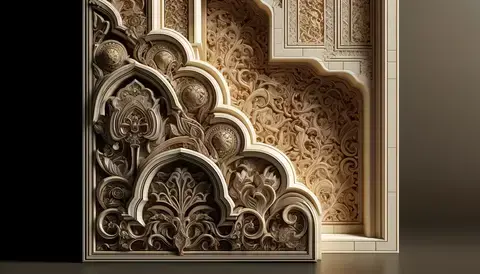
Captivating Curves and Intricate Designs: Exploring Arabesque Patterns
Imagine walking through a grand hallway adorned with swirling designs that capture the eye and ignite the imagination. This is the essence of arabesque patterns, a distinctive style in art and architecture that has fascinated people for centuries.
Introduction to Arabesque Patterns: An Overview
Arabesque patterns are known for their complex, flowing designs incorporating leafy tendrils and geometric shapes. Originating in the Islamic world, these patterns are not just decorations but carry deep cultural and spiritual significance. They represent the infinite nature of creation, reflecting the unity and orderly complexity of the universe.
Arabesque Patterns: Adding Beauty and Elegance to Islamic Art
Arabesque patterns are a distinctive feature of Islamic art, known for their intricate and flowing designs. These patterns often incorporate elements inspired by nature, such as foliage, vines, and flowers. While geometric shapes are sometimes included, arabesque patterns prioritize organic forms and asymmetry, creating a sense of movement and grace.
These intricate designs can be found in various artistic mediums, including architecture, ceramics, textiles, and decorative arts. In architecture, arabesque patterns adorn the walls, ceilings, and domes of mosques, palaces, and other Islamic buildings, adding a touch of beauty and elegance to the spaces.
One of the remarkable aspects of arabesque patterns is their versatility. They can be adapted and modified to suit different artistic styles and cultural contexts, while still retaining their characteristic beauty. This adaptability has allowed arabesque patterns to influence art and design beyond the Islamic world, inspiring artists and designers worldwide.
In addition to their aesthetic appeal, arabesque patterns hold symbolic significance in Islamic culture. They are often associated with concepts of unity, harmony, and spirituality, reflecting the interconnectedness of all things in the natural world.
Overall, arabesque patterns play a crucial role in Islamic art, adding depth, beauty, and meaning to artistic expressions. Their timeless elegance continues to captivate and inspire admirers around the globe, reminding us of the rich cultural heritage and artistic legacy of Islamic civilization.
Origins and Historical Significance
Arabesque patterns began over a thousand years ago in the Islamic world. Initially appearing in the art and architecture of the Middle East, these patterns quickly spread across the Islamic empire, from Spain to India.
Historical Timeline:
- 9th Century: Early examples in the Abbasid Caliphate.
- 12th Century: Flourished during the Islamic Golden Age.
- 17th Century: Integrated into European art and architecture.
Characteristics of Arabesque Design
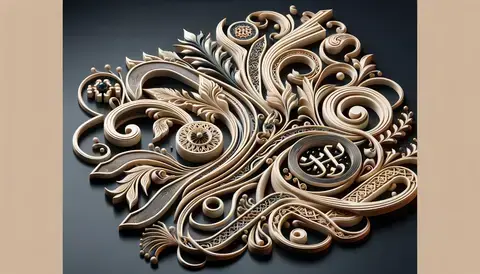
Arabesque art is characterized by its use of rhythmic linear patterns of scrolling and interlacing foliage, tendrils, or plain lines. Often, these patterns combine with other elements like geometric shapes and calligraphy, showcasing the artistry and precision of their creators.
Design Principles:
- Symmetry and Repetition: Fundamental to arabesque, reflecting the harmony of the natural world.
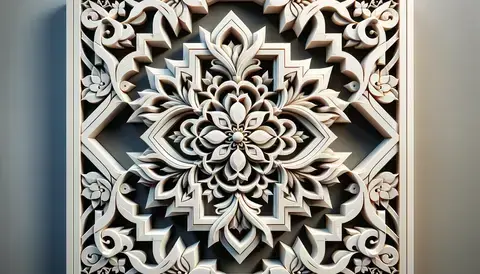
- Complexity and Continuity: The designs often appear infinitely extendable, symbolizing the unending nature of creation.
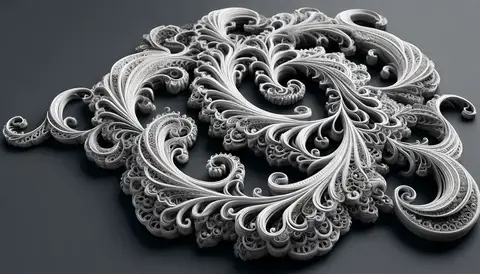
Examples and Applications in Modern Design
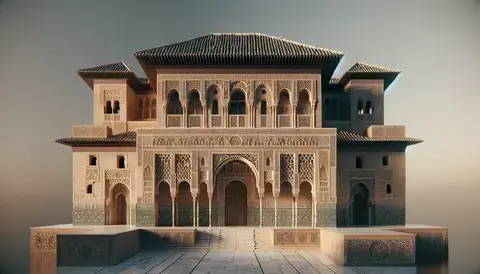
From the walls of majestic mosques to the pages of modern graphic novels, arabesque patterns are a testament to their timeless appeal and versatility.
Real-Life Examples:
- Alhambra Palace, Spain: A pinnacle of arabesque architecture with walls covered in intricate patterns.
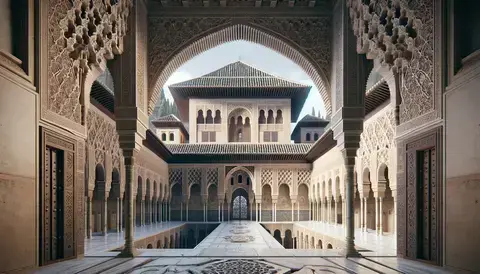
- Modern Fashion: Arabesque motifs in contemporary clothing designs, blending traditional art with modern style.
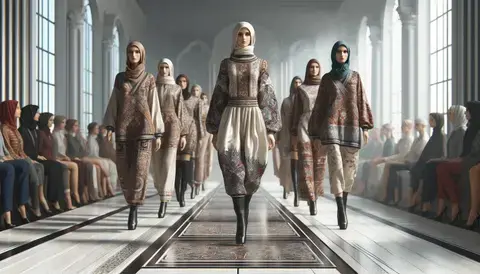
Pro Tips:
- Observation: Study real-life examples to understand the flow and integration of designs.
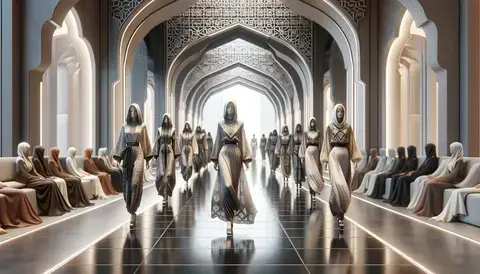
- Practice: Use tools like compasses and straightedges to create your own arabesque patterns.
Crafting Arabesque Patterns: A DIY Approach
Creating your own arabesque patterns can be both fulfilling and challenging. Start with simple forms, like circles and leaves, and gradually add layers of complexity.
Actionable Steps:
- Sketch Basic Shapes: Start with simple geometric forms.
- Add Organic Elements: Incorporate flowing lines and leaf shapes.
- Refine and Repeat: Continue refining the design and repeating elements to fill the space beautifully.
Arabesque Patterns: DIY
Creating your own arabesque patterns offers a rewarding blend of artistry and technical skill. This traditional art form, known for its intricate details and profound symbolism, can be adapted to a modern DIY approach, making it accessible for artists of all skill levels.
Getting Started with Basic Shapes
The first step in crafting arabesque patterns is to understand and utilize basic geometric forms which serve as the foundation for more elaborate designs.
Actionable Steps:
Sketch Basic Shapes: Begin your design process by sketching simple geometric shapes such as circles, squares, and triangles. These shapes form the structural base of arabesque patterns. Using a compass and a ruler can help maintain precision and symmetry, which are crucial in arabesque art.
Add Organic Elements: Once your basic shapes are laid out, start integrating organic elements. Flowing lines and leaf shapes are commonly used in arabesque designs to add natural beauty and complexity. These elements should weave seamlessly with the geometric forms, creating a harmonious blend of natural and structured components.
Refine and Repeat: The essence of arabesque lies in the repetition and meticulous refinement of patterns. Continue to refine your design by adding more details and ensuring that every element is perfectly aligned. Repetition is not merely a repetitive process but a meditative one, allowing the pattern to develop organically while maintaining a cohesive aesthetic.
Tools and Techniques for Enhanced Precision
Digital Tools: For those who are comfortable with digital technology, graphic design software like Adobe Illustrator or free alternatives like Inkscape can be invaluable. These tools allow for the easy manipulation of shapes and the precise alignment necessary for arabesque patterns.
Tracing and Transfer Techniques: Traditional methods like tracing paper or carbon paper can be used to repeat designs accurately. This helps in maintaining the uniformity essential to arabesque art.
Exploring Further with Advanced Patterns
As your confidence grows, you can experiment with more complex designs and incorporate various colors and textures. This progression from simple to complex not only enhances your skill set but also deepens your appreciation for the intricacy and depth of arabesque art.
The Artistic Journey of Arabesque
Creating arabesque patterns is more than just a crafting activity; it's a journey into the history and culture of Islamic art. By engaging in this DIY process, you gain a deeper understanding of the mathematical and aesthetic principles that underpin this beautiful art form. Whether for personal enjoyment or as part of a professional exploration of artistic styles, crafting arabesque patterns offers a unique blend of challenge and reward.
Trends in Arabesque Art: 2024
In 2024, digital tools have revolutionized how artists create and replicate arabesque patterns, making these historical designs more accessible and adaptable to various modern applications.
Updated Trends in Arabesque Art: 2024 Perspective
As we step into 2024, the landscape of arabesque art is witnessing a transformative shift, largely driven by advancements in digital technology. The intricate and historically rich patterns of arabesque art are experiencing a renaissance, not through traditional means, but via the capabilities of modern digital tools. This shift is not only enhancing the artistic process but also broadening the accessibility and application of arabesque designs across various fields.
Revolutionizing Creation and Replication
Digital tools, such as advanced graphic design software and 3D modeling applications, have significantly changed how artists and designers approach arabesque patterns. These tools offer:
- Precision and Complexity: Artists can now achieve higher precision and incorporate complex designs more easily than ever before. Digital software allows for exact measurements and symmetry that were previously challenging and time-consuming to achieve by hand.
- Experimentation and Innovation: With digital tools, artists can experiment with traditional patterns in new ways, altering scales, colors, and forms to create unique variations that still respect the essence of traditional arabesque art.
Enhancing Accessibility
Digitalization has made these ornate patterns more accessible to a global audience. Artists and designers from around the world can share their work online, learn from others, and even collaborate without geographical boundaries. Furthermore, digital tutorials and online workshops have made learning the techniques of arabesque pattern creation accessible to anyone with internet access.
Broader Applications
The adaptability provided by digital tools means that arabesque patterns are being used in more diverse ways than traditional architectural decorations or manuscript illuminations. Modern applications include:
- Fashion: Integrating arabesque patterns into textile designs using digital printing techniques.
- Interior Design: Creating bespoke furniture and home decor items that feature arabesque designs, crafted using computer-aided design (CAD) software.
- Public Art: Large-scale installations and murals featuring arabesque motifs can be planned and executed with precision using digital mapping tools.
Looking Ahead
The trend of digital integration into arabesque art is poised to continue growing, as technological advancements open new avenues for artistic expression and cultural exchange. As these patterns become more intertwined with modern technology, their potential to inspire and innovate is boundless. Arabesque art in 2024 not only honors a rich heritage but also embraces the future, ensuring that this ancient form of artistic expression remains relevant and vibrant in today’s digital age.
Key Takeaways on Arabesque Patterns
As we wrap up our exploration of arabesque patterns, it's essential to recognize that their significance extends well beyond their visual allure. Here are the crucial insights to remember:
Cultural Identity and Heritage: Arabesque patterns are not just decorative elements; they are deeply ingrained in the cultural fabric of the regions they originate from. They reflect the artistic, religious, and social values of the Islamic world, serving as a bridge between past and present cultures.
Artistic Expression: These patterns demonstrate the high level of skill and artistic devotion required to create them. The precision and detail in arabesque artistry are testaments to the craftsmen's dedication to their craft.
Symbolism and Philosophy: Arabesque patterns are rich in symbolism, often representing the infinite nature of the universe and the eternal life that the Islamic faith embodies. Their repetitive, interlacing designs symbolize the interconnectedness of all things and the continuous cycle of growth and renewal.
Versatility in Application: From architecture and textiles to modern digital graphics and fashion, arabesque patterns have been adapted for various uses over centuries. Their ability to evolve while maintaining their distinctiveness is a testament to their versatility and timeless appeal.
Appreciation and Understanding: By studying the origins, evolution, and techniques of arabesque patterns, we can appreciate not only their beauty but also the intellect and spiritual depth they represent. This appreciation deepens our understanding of not just the art form itself but also the cultures from which it springs.
By studying the world of arabesque patterns, we uncover a fascinating blend of art, history, and spirituality, revealing patterns that are as meaningful as they are beautiful. This exploration encourages us to appreciate the complexity and depth behind one of the world’s most enduring artistic traditions.
FAQs about Arabesque Patterns
What is the cultural significance of arabesque patterns?
- Arabesque patterns symbolize the infinite and the eternal, reflecting important spiritual concepts in Islamic art.
How are arabesque patterns used in modern design?
- These patterns are prevalent in everything from architecture to fashion, demonstrating their adaptability and enduring appeal.
Can beginners create arabesque patterns?
- Yes, with practice and understanding of basic design principles, anyone can start creating simple arabesque designs.
Further Exploration
For those captivated by the beauty and complexity of arabesque patterns and seeking to deepen their understanding, there are a wealth of resources available. Exploring these patterns through various mediums not only enriches one's appreciation of their artistic and cultural significance but also enhances practical skills in design and art history.
Books on Arabesque Patterns
"Islamic Geometric Patterns" by Eric Broug
- This book provides a comprehensive look at the techniques behind creating geometric patterns, accompanied by step-by-step instructions for drawing them. Broug explains the historical and cultural context of these designs in Islamic art.
"The Art of Islamic Pattern: Studies in Geometry and Ornament" by Richard Henry and Adam Williamson
- This book serves as both a practical guide to creating your own patterns and a deep dive into the philosophical and spiritual meanings behind them. It’s richly illustrated with examples from around the Islamic world.
"Arabesque: Graphic Design from the Arab World and Persia" by Ben Wittner and Sascha Thoma
- Focusing on contemporary graphic design, this book showcases how traditional arabesque patterns are being reinterpreted in modern art and design, offering a bridge between past and present.
Online Courses on Arabesque Patterns
"Arabesque Pattern Making" on Coursera
- Offered by an experienced designer specializing in Islamic patterns, this course teaches the foundations of pattern making, from drawing basic shapes to creating intricate arabesque designs using advanced software.
"The Geometry of Islamic Art" on edX
- Learn the mathematical principles behind Islamic geometric and arabesque patterns in this course that combines theory with hands-on activities. It is ideal for both math enthusiasts and artists.
"Islamic Art and Architecture" on Khan Academy
- This free course offers a broader look at Islamic art, providing context for arabesque patterns within the wider scope of Islamic architecture and decorative arts.
Further Learning and Exploration
These resources can serve as starting points for both casual enthusiasts and serious students. Engaging with these books and courses not only enhances understanding but also provides practical skills in creating and interpreting arabesque patterns. For those looking to delve even deeper, attending workshops or lectures by experts in the field can offer additional insights and networking opportunities.
For designers, artists, and historians, understanding arabesque patterns is an enriching journey that connects the dots between mathematics, art, and spirituality, revealing the profound unity and beauty that these patterns represent.
This guide provides a comprehensive look at arabesque patterns, making it a valuable resource for students, designers, and anyone intrigued by the blend of art, history, and culture.
